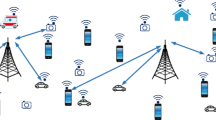Abstract
The Distributed Queuing with Collision Avoidance (DQCA) Medium Access Control (MAC) protocol has been presented in the literature as a high-performance protocol for WLANs. Previous work regarding DQCA is focused on the operation of a single cell, where no interaction with neighboring sites is considered. In this paper, we define specific handoff procedures (channel sensing, discovery and reassociation functions) that enable the roaming of users in a scenario consisting of several DQCA access points (APs) deployed in a specific area using non-overlapping channel frequencies. Furthermore, we introduce a number of AP selection mechanisms in order to provide efficient reassociation decision criteria in the context of DQCA. These mechanisms are based either on a single metric such as the Signal to Noise Ratio (SNR) or the traffic load, or on cross-layer design by combining the information from different layers. Finally, our proposed solutions are evaluated by means of computer simulations.












Similar content being viewed by others
Explore related subjects
Discover the latest articles, news and stories from top researchers in related subjects.References
Alonso-Zárate, J., Verikoukis, C., Kartsakli, E., Cateura, A., & Alonso, L. (2008). A near-optimum cross-layered distributed queuing protocol for WLAN. IEEE Wireless Communications Magazine, 15(1), 48–55. Special issue on Medium Access Control Protocols for Wireless LANs.
Mhatre, V., & Papagiannaki, K. (2006). Using smart triggers for improved user performance in 802.11 wireless networks. In Proceedings of the 4th international conference on mobile systems, applications and services, June 19–22, Uppsala, Sweden.
Cisco systems. Deployment guide: Cisco Aironet 1000 series lightweight access points.
Bejerano, Y., & Bhatia, R. S. (2006). MiFi: a framework for fairness and QoS assurance for current IEEE 802.11 networks with multiple access points. IEEE/ACM Transactions on Networking, 14(4), 849–862.
Mishra, A., Shin, M., & Arbaugh, W. A. (2003). An empirical analysis of the IEEE 802.11 MAC layer handoff process. ACM SIGCOMM Computer Communication Review, 33(2), 93–102.
Judd, G., & Steenkiste, P. (2002). Fixing 802.11 access point selection. ACM SIGCOMM Computer Communication Review, 32(3), 31.
Siris, V. A., & Evaggelatou, D. (2007). Access point selection for improving throughput fairness in wireless LANs. In 10th IFIP/IEEE international symposium on integrated network management, 21 May 2007, 469–477.
Koutsopoulos, I., & Tassiulas, L. (2007). Joint optimal access point selection and channel assignment in wireless networks. IEEE/ACM Transactions on Networking, 15(3), 521–532.
Vasudevan, S., Papagiannaki, K., Diot, C., Kurose, J., & Towsley, D. (2005). Facilitating access point selection in IEEE 802.11 wireless networks. In ACM Sigcomm IMC, Berkeley, USA.
Karetsos, G., Tragos, E., & Tsiropoulos, G. (2011). A holistic approach to minimizing handover latency in heterogeneous wireless networking environments. Telecommunication Systems Journal, 2011, 1–14.
Heusse, M., Rousseau, F., Berger-Sabbatel, G., & Duda, A. (2003). Performance anomaly of 802.11b. In Proceedings of the INFOCOM (pp. 836–843).
Chen, Y.-S., Hsiao, W.-H., & Chiu, K.-L. (2007). Cross-layer partner-based fast handoff mechanism for IEEE 802.11 wireless networks. In IEEE 66th vehicular technology conference, 2007. VTC-2007 Fall, Oct. 3, 2007, pp. 1474–1478.
Song, Y., Liu, M., Zhou, A., Li, Z., & Li, Q. (2010). PCLF: a practical cross-layer fast handover mechanism in IEEE 802.11 WLANs. In IEEE international conference on communications (ICC), 23–27 May 2010 (pp. 1–5).
Lee, K.-H., Lee, H.-W., Ruy, W., & Han, Y.-H. (2013). A scalable network-based mobility management framework in heterogeneous IP-based networks. Telecommunication Systems Journal, 52(4), 1989–2002.
IEEE standard for information technology—specific require-ments—Part 11: Wireless LAN medium access control (MAC) and physical layer (PHY) specifications. IEEE Std 802.11-2007 (Revision of IEEE Std 802.11-1999), pp. C1-1184, June 12, 2007.
Campbell, G. M., & Xu, W. (September 2001). Method and apparatus for detecting collisions on and controlling access to a transmission channel. United States Patent 6292493.
Capetanakis, J. I. (1979). Tree algorithm for packet broadcast channels. IEEE Transactions on Information Theory, 25(5), 505–515.
Capetanakis, J. I. (1979). Generalized TDMA: the multi-accessing tree protocol. IEEE Transactions on Communications, 27(10), 1476–1484.
Tsybakov, B. S., & Mikhailov, V. A. (1978). Free synchronous packet access in a broadcast channel with feedback. Problems of Information Transmission, 14(4), 259–280.
Tamminen, J. (November 2002). 2.4 GHz WLAN radio interface. Available at http://wikiaccess.cttc.es/images/4/48/2.4_GHz_WLAN_Radio.pdf.
Rappaport, T.S. (1996). Wireless communications principles and practice. New York: Prentice Hall.
Del Prado, J., & Choi, S. (2003). Link adaptation strategy for IEEE 802.11 WLAN via received signal strength measurement. In ICC’03, Anchorage, Alaska, May 2003, pp. 1108–1113.
Acknowledgements
This work has been funded by the Research Projects GREENET (PITN-GA-2010-264759), CO2GREEN (TEC-2010-20823), Green-T (CP8-006) and R2D2 (CP6-013).
Author information
Authors and Affiliations
Corresponding author
Rights and permissions
About this article
Cite this article
Antonopoulos, A., Alonso-Zárate, J., Kartsakli, E. et al. Cross layer access point selection mechanisms for a distributed queuing MAC protocol. Telecommun Syst 53, 329–342 (2013). https://doi.org/10.1007/s11235-013-9701-6
Published:
Issue Date:
DOI: https://doi.org/10.1007/s11235-013-9701-6




